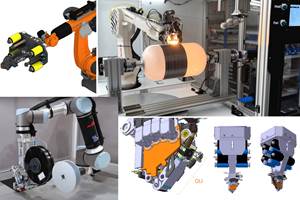Tooling: 3D printing’s “killer app”
If 3D printing can be scaled to make tools for composite auto body panels ... it will be transformative
Recently, I attended the Additive Manufacturing Conference in Knoxville, TN, US, hosted by CW parent organization (Cincinnati, OH, US). It was evident, there, that great strides are being made in this technology’s advancement. What was on display and discussed was almost all 3D printing technology. As I mentioned in this column in August 2015, “all 3D printing is, indeed, additive manufacturing; but not all additive manufacturing is 3D printing.” I still struggle that these are conflated terms, because one is, technically, a subset of the other, but I’ll put that aside because I believe 3D printing/additive manufacturing has great potential in the composites industry.
3D-printed metallic structures, especially those for the low-volume and very convoluted shapes found in jet and rocket engines, seem to be a perfect fit. Excellent properties are obtained in these parts, and the ability to embed flow channels and other geometrically complex features provides real value in replacing machined or cast metal parts. Although some companies are employing polymer-based 3D printing to build end-use components, I don’t foresee 3D printing achieving the strength-to-weight ratio necessary to replace continuous fiber-reinforced composites on a mass scale. Likewise, in high-volume parts, it would be hard for 3D printing to displace discontinuously reinforced materials (SMC or long-fiber thermoplastics) given the short cycle times achieved today.
That doesn’t mean there isn’t a place for this technology in the advanced composites market. Two companies, Cincinnati Incorporated (Harrison, OH) and Thermwood Corp. (Dale, IN, US), are selling large, extruder-based polymer additive machines able to print parts more than 6m long, and Ingersoll Machine Tools (Rockford, IL, US) is developing a system targeted at parts up to five times this size. Several service bureaus have been established to supply large, printed polymer parts to third-party customers. Software suppliers have been active, with slicing programs that create print paths and applications that can perform topology optimization and predict polymer crystallization, cooling rates, residual stress and part warpage. So, for low volumes and lightly loaded structures, there are likely to be plenty of needs to fill.
And 3D printing’s unique ability to cost-effectively realize one-off, custom designs suggests that this market’s killer application will be tooling for making composite parts, rather than the parts themselves. It’s already happening on the aerospace side. In 2016, Oak Ridge National Laboratory (ORNL, Oak Ridge, TN, US), in cooperation with The Boeing Co. (Chicago, IL, US), printed a 5.3m long trim-and-drill fixture for the 777-9 program from carbon fiber-filled ABS, which weighed 750 kg. Built in 30 hours, using a machine from Cincinnati Inc., the tool is listed by the Guinness Book of World Records as the world’s largest solid, 3D-printed item. Although this trim tool operates at room temperature, ORNL has produced tools in high-temperature carbon fiber-filled polymers, such as PPS, which are able to withstand the 7-bar/175°C environment of the autoclave. At the conference in Knoxville, Thermwood displayed a carbon fiber-filled polysulfone (PSU) tool, along with parts produced from it via autoclave.
Nonaerospace applications also present opportunities. In 2016, TPI Composites Inc. (Warren, RI, US) received a contract from Sandia National Laboratory (Albuquerque, NM, US) to fabricate a limited number of 13m-long wind turbine blades for testing. Given that conventional machined plug/layup tooling processes can take 6 to 12 months, TPI worked with ORNL to print modules from carbon fiber/ABS, then connected these and applied layers of fiberglass/epoxy and a finish coat to manufacture the tools in less than half the time and at lower cost. The tools include integrated hot-air heating channels, replacing the typical resistive electric wire heating. Purdue University has printed small compression molding tools using thermoplastics that are able to withstand 500-psi and 175°C, and is designing tools able to make 10-50 prototype parts via compression and injection molding, and RTM.
Back in the 3D metal-printing world, ORNL, working with Wolf Robotics LLC (Ft. Collins, CO, US), has deployed a large-format, robotic welding-like process to manufacture a steel arm for an excavator. A new project, initiated by the Institute for Advanced Composites Manufacturing Innovation (IACMI, Knoxville, TN, US), with ORNL, seeks to leverage the Wolf Robotics innovation to develop metallic tooling for high-rate processes, with similar longevity to conventional tool steels, and more than 50% reduction in fabrication time and cost. With the potential to incorporate conformal heating and cooling, and to modify the tool quickly, this technology could be truly transformative if it can be scaled to make production tooling sized for automotive parts like body panels and floor pans. It’s not a question of if, but when.
Related Content
Low-cost, efficient CFRP anisogrid lattice structures
CIRA uses patented parallel winding, dry fiber, silicone tooling and resin infusion to cut labor for lightweight, heavily loaded space applications.
Read MoreOtto Aviation launches Phantom 3500 business jet with all-composite airframe from Leonardo
Promising 60% less fuel burn and 90% less emissions using SAF, the super-laminar flow design with windowless fuselage will be built using RTM in Florida facility with certification slated for 2030.
Read MoreIndustrializing additive manufacturing in the defense/aerospace sector
GA-ASI demonstrates a path forward for the use of additive technologies for composite tooling, flight-qualified parts.
Read MoreThe next evolution in AFP
Automated fiber placement develops into more compact, flexible, modular and digitized systems with multi-material and process capabilities.
Read MoreRead Next
Assembling the Multifunctional Fuselage Demonstrator: The final welds
Building the all-thermoplastic composite fuselage demonstrator comes to an end with continuous ultrasonic welding of the RH longitudinal fuselage joint and resistance welding for coupling of the fuselage frames across the upper and lower halves.
Read MoreAll-recycled, needle-punched nonwoven CFRP slashes carbon footprint of Formula 2 seat
Dallara and Tenowo collaborate to produce a race-ready Formula 2 seat using recycled carbon fiber, reducing CO2 emissions by 97.5% compared to virgin materials.
Read MoreComposites end markets: New space (2025)
Composite materials — with their unmatched strength-to-weight ratio, durability in extreme environments and design versatility — are at the heart of innovations in satellites, propulsion systems and lunar exploration vehicles, propelling the space economy toward a $1.8 trillion future.
Read More











